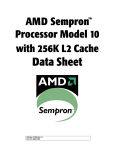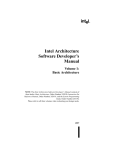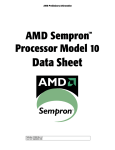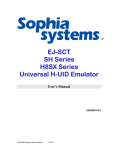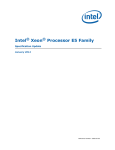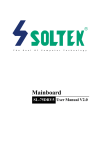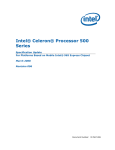Download AMD Athlon 6 User's Manual
Transcript
Preliminary Information AMD Athlon™ Processor Model 6 Revision Guide Publication # 24332 Rev: E Issue Date: December 2002 Preliminary Information © 2001, 2002 Advanced Micro Devices, Inc. All rights reserved. The contents of this document are provided in connection with Advanced Micro Devices, Inc. (“AMD”) products. AMD makes no representations or warranties with respect to the accuracy or completeness of the contents of this publication and reserves the right to make changes to specifications and product descriptions at any time without notice. No license, whether express, implied, arising by estoppel or otherwise, to any intellectual property rights is granted by this publication. Except as set forth in AMD’s Standard Terms and Conditions of Sale, AMD assumes no liability whatsoever, and disclaims any express or implied warranty, relating to its products including, but not limited to, the implied warranty of merchantability, fitness for a particular purpose, or infringement of any intellectual property right. The AMD products described herein may contain design defects or errors (“Product Errata”) that cause AMD products to deviate from published specifications. Currently characterized Product Errata may be available upon request. AMD’s products are not designed, intended, authorized or warranted for use as components in systems intended for surgical implant into the body, or in other applications intended to support or sustain life, or in any other application in which the failure of AMD’s product could create a situation where personal injury, death, or severe property or environmental damage may occur. AMD reserves the right to discontinue or make changes to its products at any time without notice. Trademarks AMD, the AMD Arrow logo, AMD Athlon, and combinations thereof, are trademarks of Advanced Micro Devices, Inc. Other product names used in this publication are for identification purposes only and may be trademarks of their respective companies. Preliminary Information AMD Athlon™ Processor Model 6 Revision Guide 24332E—December 2002 Revision History Date Rev Description December 2002 E Added errata #22–24. July 2002 D Added errata #20 and #21. ■ ■ October 2001 C ■ ■ May 2001 B Added silicon revision A5 information Added erratum #18 and #19 Added Table 2: Cross-reference of Erratum to Processor Segments to include all processor segments Updated reference documents listed in section 3.1 Initial public release. 3 Preliminary Information AMD Athlon™ Processor Model 6 Revision Guide 24332E—December 2002 AMD Athlon™ Processor Model 6 Revision Guide The purpose of the AMD Athlon™ Processor Model 6 Revision Guide is to communicate updated product information on the AMD Athlon processor model 6 to designers of computer systems and software developers. This revision guide applies to the AMD Athlon processor model 6, mobile AMD Athlon processor model 6, and AMD Athlon MP processor model 6. This guide consists of three sections: ■ Product Errata: This section, which starts on page 5, provides a detailed description of product errata, including potential effects on system operation and suggested workarounds. An erratum is defined as a deviation from the product’s specification. A product errata may cause the behavior of the AMD Athlon processor model 6 to deviate from the published specifications. ■ Revision Determination: This section, which starts on page 16, shows the AMD Athlon processor model 6 identification numbers returned by the CPUID instruction for each revision of the processor. ■ Technical and Documentation Support: This section, which starts on page 17, provides a listing of available technical support resources. It also lists corrections, modifications, and clarifications to listed documents. Please refer to the data sheets listed in this section for product marking information. Revision Guide Policy Occasionally AMD identifies deviations from or changes to the specification of the AMD Athlon processor model 6. These changes are documented in the AMD Athlon™ Processor Model 6 Revision Guide as errata. Descriptions are written to assist system and software designers in using the AMD Athlon processor model 6 and corrections to AMD’s documentation on the AMD Athlon processor model 6 are included. This release documents currently characterized product errata. 4 Preliminary Information 24332E—December 2002 1 AMD Athlon™ Processor Model 6 Revision Guide Product Errata This section documents AMD Athlon™ Processor Model 6 product errata. The errata are divided into categories to assist referencing particular errata. A unique tracking number for each erratum has been assigned within this document for user convenience in tracking the errata within specific revision levels. Table 1 cross-references the revisions of the processor to each erratum. An “X” indicates that the erratum applies to the stepping. The absence of an “X” indicates that the erratum does not apply to the stepping. Table 2 on page 6 cross-references erratum to each processor segment. An “X” indicates that the erratum applies to the processor segment. Note: Table 1. There can be missing errata numbers. Errata that have been resolved from early revisions of the processor have been deleted, and errata that have been reconsidered may have been deleted or renumbered. Cross-Reference of Product Revision to Errata Revision Numbers Errata Numbers and Description A0 A2 16 INVLPG Instruction Does Not Flush Entire Four-Megabyte Page Properly with Certain Linear Addresses X X 17 Deadlock May Occur in a Two-Processor System in the Presence of Probe to Memory- Mapped I/O X X 18 Processor May Issue Non-Connect Bus Cycle After FID Special Cycle X X 19 Processor Does Not Support Reliable Microcode Patch Mechanism A5 X X 20 Processor Performance Counters Do Not Count Some x86 Instructions X X X 21 A Speculative SMC Store Followed by an Actual SMC Store May Cause OneTime Stale Execution X X X 22 Real Mode RDPMC with Illegal ECX May Cause Unpredictable Operation X X X 23 Using Task Gates With Breakpoints Enabled May Cause Unexpected Faults X X X 24 Single Step Across I/O SMI Skips One Debug Trap X X X 5 Preliminary Information AMD Athlon™ Processor Model 6 Revision Guide Table 2. 24332E—December 2002 Cross-Reference of Erratum to Processor Segments Errata Number Workstation/Server1 Desktop2 Mobile3 16 X X X 17 X X 18 19 X X X 20 X X X 21 X X X 22 X X X 23 X X X 24 X X X Notes: 1. The workstation/server segment currently includes the AMD Athlon™ MP processor. 2. The desktop segment currently includes the AMD Athlon XP processor. 3. The mobile segment currently includes the AMD Athlon 4 processor. 6 Preliminary Information 24332E—December 2002 16 AMD Athlon™ Processor Model 6 Revision Guide INVLPG Instruction Does Not Flush Entire Four-Megabyte Page Properly with Certain Linear Addresses Products Affected. A0, A2 Normal Specified Operation. After executing an INVLPG instruction the TLB should not contain any translations for any part of the page frame associated with the designated logical address. Non-conformance. When the logical address designated by the INVLPG instruction is mapped by a 4Mbyte page mapping and LA[21] is equal to one it is possible that the TLB will still retain translations after the instruction has finished executing. Potential Effect on System. The residual data in the TLB can result in unexpected data access to stale or invalid pages of memory. Suggested Workaround. When using the INVLPG instruction in association with a page that is mapped via a 4-Mbyte page translation, always clear bit 21. Resolution Status. Fix planned for a future revision. 7 Preliminary Information AMD Athlon™ Processor Model 6 Revision Guide 17 24332E—December 2002 Deadlock May Occur in a Two-Processor System in the Presence of Probe to MemoryMapped I/O Products Affected. A0, A2, A5 Normal Specified Operation. Processor should not hang. Non-conformance. In a multiprocessor system, if one processor (A) is continuously writing to a cacheable memory-mapped I/O block while the other processor (B) is trying to read the same cacheable I/O block, and at the same time both processors are also trying to write a different memory-based cache block, then processor B may hang. Should this occur and processor A fields an interrupt, the deadlock will be resolved. Potential Effect on System. System will hang or exhibit performance degradation. Suggested Workaround. The current processor design assumes that memory-mapped I/O is incoherent and does not handle all deadlock cases. System logic should not generate probes for memory mapped I/O addresses. Resolution Status. No fix planned. 8 Preliminary Information 24332E—December 2002 18 AMD Athlon™ Processor Model 6 Revision Guide Processor May Issue Non-Connect Bus Cycle After FID Special Cycle Products Affected. A0, A2 Normal Specified Operation. The first processor cycle after a FID Change special cycle should be a Connect special cycle. Non-conformance. In rare circumstances, a processor victim write may be pending inside the processor when the FID Change special cycle is issued. Several bus clocks later, the WrVictimBlk command for the victim will be issued. This violates the specification, which states that all processor-based commands should be finished before the FID change special cycle. Potential Effect on System. The core logic may become confused. Suggested Workaround. System core logic can wait for numerous bus clocks after receiving the FID change special cycle before attempting to disconnect in order to generate a window sufficiently large enough to allow the WrVictimBlk transaction to take place prior to the disconnect. Resolution Status. Fix planned for a future revision. 9 Preliminary Information AMD Athlon™ Processor Model 6 Revision Guide 19 24332E—December 2002 Processor Does Not Support Reliable Microcode Patch Mechanism Products Affected. A5 Normal Specified Operation. The processor should function properly after a microcode patch is loaded. Non-conformance. The processor has the patch RAM BIST function disabled. Since BIST is not run on the patch RAM, reliable operation of the patch RAM cannot be guaranteed. Therefore it should not be used. Potential Effect on System. When a microcode patch is loaded, the system may not behave properly. Suggested Workaround. Do not load a microcode patch. Resolution Status. Fix planned for a future revision. 10 Preliminary Information 24332E—December 2002 20 AMD Athlon™ Processor Model 6 Revision Guide Processor Performance Counters Do Not Count Some x86 Instructions Products Affected. A0, A2, A5 Normal Specified Operation. The processor should count all x86 instructions when programmed to do so. Non-conformance. There are two types of uncounted instructions. One set of instructions is always uncounted. Another set of instructions are uncounted only if a certain data dependency exists. Instructions never counted are: RDMSR, WRMSR, FSTENV, FSAVE, FLDENV, FPTAN, FYL2XP1, FCLEX, LLDT, LTR, MOV CRx, LGDT, LIDT, INVLPG, INVD, WBINVD, MOV DRx, CPUID, and SFENCE. Instructions that are uncounted only when certain data dependencies exist are: ■ LAR, LSL, VERR, VERW if they clear the Zero Flag ■ FXSAVE, FXRSTOR if FERR is changed ■ FPU instructions with exceptional data conditions ■ IO instructions that detect an interrupt ■ POPF with the trap flag =1 ■ POPFD and PUSHFD with IOPL not equal 3 and Virtual Mode enabled ■ POPFD when Alignment Check is being enabled ■ MOV SS with the trap flag =1 ■ Segment Loads that generate accessed bit exceptions ■ STI with the trap flag or the interrupt flag already a 1 ■ CLTS with the CR0.TS flag =1 ■ LMSW that changes any bit Potential Effect on System. Performance counter may under count the actual number of x86 instructions. Suggested Workaround. Versions of the AMD Athlon™ processor not affected by this erratum may be used to gather instruction counts. Resolution Status. No fix planned. 11 Preliminary Information AMD Athlon™ Processor Model 6 Revision Guide 21 24332E—December 2002 A Speculative SMC Store Followed by an Actual SMC Store May Cause One-Time Stale Execution Products Affected. A0, A2, A5 Normal Specified Operation. Self-modifying code sequences should be correctly detected and handled in a manner consistent with canonical results; stale code should not be executed. Non-conformance. The following scenario can result in a one-time execution of stale instructions: 1. A speculative store instruction initiates a request (R) to modify a 64-byte cache line with address A, which currently resides within the L1 instruction cache. 2. The speculative store instruction is ultimately not executed because of a branch misprediction. However, the store R is still in flight attempting to bring the line into the data cache in the modified state. 3. The instruction cache, which fetches instructions 16 bytes at a time, is redirected by the branch into the cache line with address A and fetches a portion of the line into the instruction buffer. 4. R then invalidates the instruction cache line with address A and brings the line into the L1 data cache, marking it as modified. However, the instruction buffer, which also contains some bytes from address A, is not invalidated. 5. The instruction fetch mechanism attempts to read the next 16-byte chunk of code and must issue a request to bring the 64-byte line back into the instruction cache. 6. This instruction cache request for address A hits on the modified line now in the L1 cache, and evicts it from the data cache to the L2. 7. A second store instruction (S) from the instruction buffer is issued into the execution units. S is a self-modifying code reference to another instruction that currently exists in the 64-byte cache block at address A and is also in the instruction buffer. 8. The execution of S detects that an instruction request to fetch address A is in flight. However, the store request is given priority. Since it now hits in the L2 and the L2 state is modified, it assumes that the line cannot be in the instruction cache or the instruction buffer. Potential Effect on System. The processor will execute stale code instructions. Suggested Workaround. None. This failure has only been observed in internally generated synthetic code. Resolution Status. No fix planned. 12 Preliminary Information 24332E—December 2002 22 AMD Athlon™ Processor Model 6 Revision Guide Real Mode RDPMC with Illegal ECX May Cause Unpredictable Operation Products Affected. A0, A2, A5 Normal Specified Operation. Illegal values of ECX (that is, ECX>3) for the RDPMC (Read Performance Monitor Counter) instruction cause the processor to take a general protection exception. Non-conformance. If the RDPMC is executed in real mode with a specific illegal value of ECX=4, then the processor may incorrectly enter the GP fault handler as if it were in 32-bit real mode. Potential Effect on System. Incorrect instruction decode leading to unpredictable system failure. Suggested Workaround. When in real mode, restrict use of the RDPMC instruction to legal counter values (0-3). This circumstance is not expected to occur in normal operation and has only been detected in a simulation environment. Resolution Status. No fix planned. 13 Preliminary Information AMD Athlon™ Processor Model 6 Revision Guide 23 24332E—December 2002 Using Task Gates With Breakpoints Enabled May Cause Unexpected Faults Products Affected. A0, A2, A5 Normal Specified Operation. Task gates should correctly use the TSS selector out of the task gate for CALL and JMP instructions. Non-conformance. When a task gate is used by a CALL or JMP instruction and any debug breakpoint is enabled through the DR7.LE or GE bits, the processor may, under certain timing scenarios, incorrectly use the new TSS base[15:0] contained in the new TSS as a selector. This will most likely cause a GP fault with an error code of the new TSS base. Potential Effect on System. System failure. Suggested Workaround. When using software that uses task gates with CALL or JMP instructions, do not enable breakpoints. Resolution Status. No fix planned. 14 Preliminary Information 24332E—December 2002 24 AMD Athlon™ Processor Model 6 Revision Guide Single Step Across I/O SMI Skips One Debug Trap Products Affected. A0, A2, A5 Normal Specified Operation. When single stepping (with EFLAGS.TF) across an IN or OUT instruction that detects an SMI, the processor correctly defers taking the debug trap and instead enters SMM. Upon RSM (without I/O restart), the processor should immediately enter the debug trap handler. Non-conformance. Under this scenario, the processor does not enter the debug trap handler but instead returns to the instruction following the I/O instruction. Potential Effect on System. When using the single step debug mode, following an I/O operation that detects an SMI, one instruction may appear to be skipped. Suggested Workaround. None required as this is a debug limitation only. If a workaround is desired, modify the SMM handler to detect this case and enter the debug handler directly. Resolution Status. No fix planned. 15 Preliminary Information AMD Athlon™ Processor Model 6 Revision Guide 2 24332E—December 2002 Revision Determination Table 3 shows the AMD Athlon™ processor model 6 identification numbers returned by the CPUID instruction for each revision of the processor. Table 3. 16 CPUID Values for the Revisions of the AMD Athlon™ Processor Model 6 Revision CPUID A0 660 A2 661 A5 662 Preliminary Information 24332E—December 2002 3 AMD Athlon™ Processor Model 6 Revision Guide Technical and Documentation Support The following documents provide additional information regarding the operation of the AMD Athlon™ processor model 6. Please refer to the data sheets listed in this section for product marking information. ■ AMD Athlon™ XP Processor Data Sheet: Processor Model 6, order #24309 ■ Mobile AMD Athlon™ 4 Processor Model 6 CPGA Data Sheet, order #24319 ■ AMD Athlon™ MP Processor Model 6 Data Sheet Multiprocessor-Capable for Workstation and Server Platforms, order #24685 ■ AMD Athlon™ MP Processor OPGA Data Sheet for Multiprocessor Platforms: Processor Model 6, order #25480 For the latest updates, refer to www.amd.com and download the appropriate files. For documents under NDA, please contact your local sales representative for updates. 17

















